Designing for Multifamily Housing
CONNECTING INDOORS AND OUTDOORS
The exterior of a building is usually thought of in terms of keeping things outside that belong outside, but there are plenty of times when people want to connect with the outdoors, too. That connection could be in terms of windows or doors that allow visual or direct access to patios or other private spaces. It could also be through the creation of outdoor spaces specifically designed to be used and enjoyed by residents and visitors to multifamily buildings.
Opening Glass Walls
Many multifamily housing projects of all types include an outdoor balcony, porch, deck, or similar space as part of a living unit. This is often a very sought-after trait by the people living in the units, which means they also add value to the property for the building owner. Commonly, the access to such a balcony or porch is through a swinging or sliding glass door. However, there is an alternative that is proving to be very effective at adding a “wow factor” to living units in the form of opening glass walls. These are made up of multiple glass panels in either wood or aluminum frames that fold or slide to create a continuous opening between the indoor living space and the outdoor balcony or porch.
Opening glass walls respond to consumer demand for connecting to the outdoors and can differentiate a multifamily property from others on the market that only use a single door. Opening glass walls provide building owners, architects, property managers, homeowner associations, and contractors with a solution for increasing usable space by allowing the balcony to feel like a direct extension of the living space. It also helps the living unit connect directly with the outdoors in a more natural and appealing manner to take advantage of days or nights with favorable weather. This sense of creating more living space has been used on balconies, porches, and even shallow Juliet balconies. In all cases, they have been shown to enhance the living unit’s value and the marketability of the entire development.
When it comes to the thermal performance and comfort of operable glass walls, it should be noted that all manufacturers are not alike. It is important to compare the performance characteristics of different products to be sure that they can meet the specified performance requirements. This will be true for the thermal performance of the products in terms of R-value or U-factor for energy efficiency and for occupant comfort. It will also be relevant for resistance to wind load and air-and-water infiltration performance requirements, particularly for mid-rise and high-rise buildings. When specified and used appropriately, opening glass walls can provide year-round benefit with an indoor/outdoor atmosphere, fresh air ventilation, and natural light in condos and apartments, particularly those with otherwise limited natural light sources.
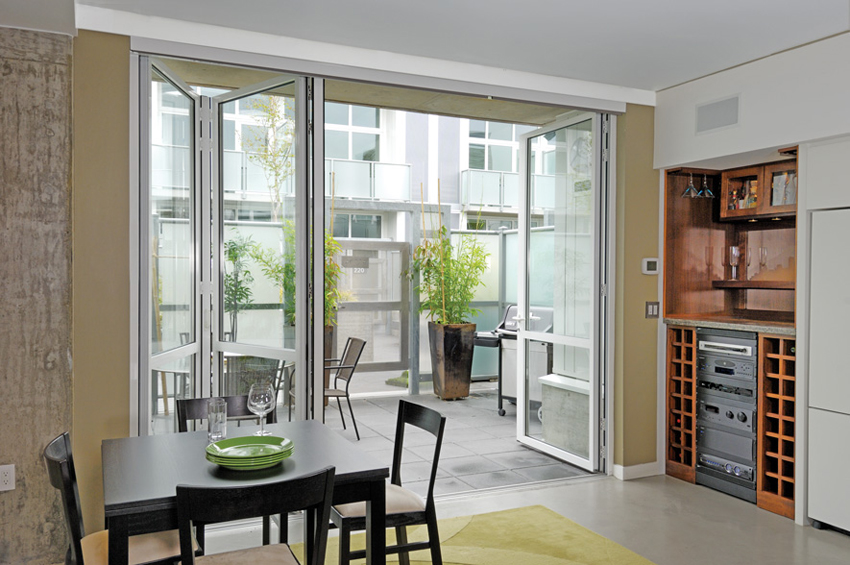
Photo courtesy of NanaWall Systems
Opening glass walls used in apartments and condo units can extend the usable living space to outdoor balconies and porches, while sealing tightly when closed.
Common Outdoor Areas
Beyond private outdoor spaces, most multifamily facilities contain common outdoor areas. These can be intentional spaces for recreation, gardens, or gathering, or they can be part of an outdoor circulation system, such as walkways, paths, etc. Either way, on-site outdoor spaces are viewed as an amenity area, and they continue to be one of the most desirable features in multifamily construction. This means that such spaces need to be identified for location within the facility, and then they need to be designed.
There are two ways that outdoor spaces are enhanced by design—one on the horizontal plane with vegetation, plantings, furnishings, or other features, and one on the vertical plane with vegetated or green walls. The horizontal design starts with a determination of the use and type of surface needed. In open courtyards, that could be grass, pavers, decking, or other similar materials. On rooftop settings, it could be similar, but could also be a green roof design intended for plantings of one type or another. The underlying structure of any of these locations needs to be taken into account, particularly if it is not level or intended to be made level. In those cases, the surface will need some form of adjustable supports that will allow for a level horizontal surface. There are many such systems available, and they are designed for ease of use, long-term durability, and proper drainage.
Once the surface is finalized, then other appropriate features can be added, such as seating, tables, planters, water features, garden features, recreational items, or whatever else suits the intended use of the outdoor space. If plantings are part of it, then attention needs to be given to how they are watered and maintained, as well as how they are installed. If the surface is not directly on the ground, thus allowing for direct plantings in the earth, then some form of pot or planter will be needed to provide a growing medium and water irrigation system. Some manufacturers do offer a self-irrigation system based on using an insert in a large pot that holds a reservoir of water and allows it to be wicked up on demand by the plants. Then the reservoir is simply topped off as needed.
“Green walls” is an all-encompassing term that is used to refer to all forms of vegetated wall surfaces. However, there are two major system categories that fall under this term’s rubric: green facades and living walls. Green facades are systems in which climbing plants or cascading groundcovers are trained to grow onto and over specially designed supporting structures, such as a trellis. A living wall, by comparison, is an integral part of an exterior building envelope system or an interior wall. In either location, a living wall is comprised of distinct panels that are either pre-vegetated or planted on-site and include growing medium or liquid nutrient.
When architects are considering any of these natural outdoor amenities, they are often seeking to work with a manufacturer to maximize the design opportunity or to help assure successful growing. This can be especially true on green roofs or green wall designs. Fortunately, that assistance is available from one or more manufacturers who have built up their design and project management teams to support the architectural and construction functions. They offer a wide range of products that make an architect’s job easier for amenity space design but may also offer to modify their existing products or create solutions from scratch. This ability to customize the outdoor amenities designs can truly help take a project to the next level.
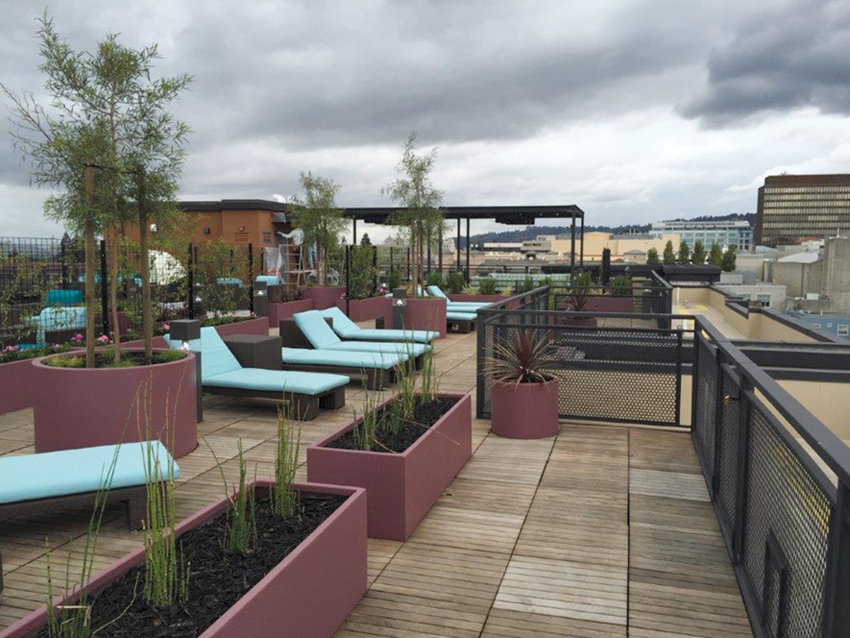
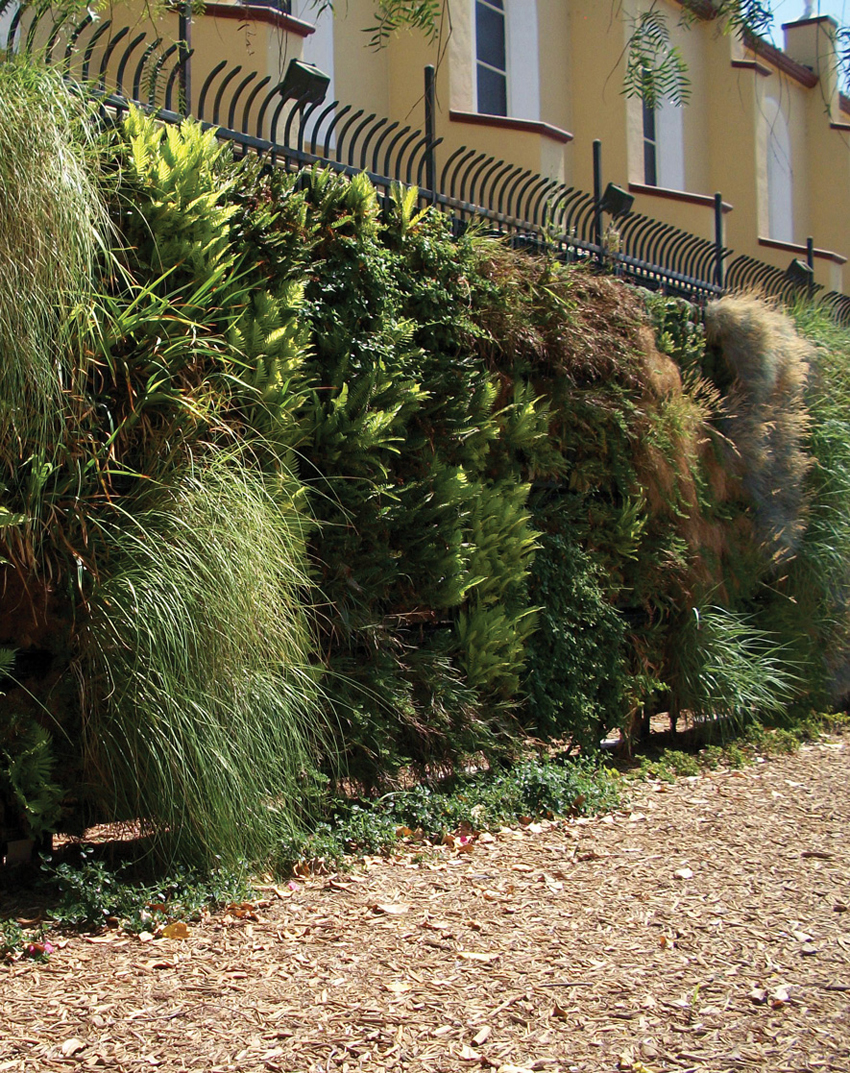
Photos courtesy of Tournesol Siteworks
Outdoor spaces become amenities when both the horizontal surfaces and the vertical surfaces are designed using decks, planters, furnishings, green walls, or green roofs.
Notice
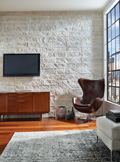
www.eldoradostone.com/modern
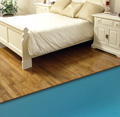
www.mpglobalproducts.com

www.nanawall.com/applications/multi-family
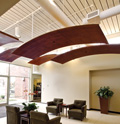
www.newmill.com

www.xtremetrim.com

www.tarkettna.com

www.tournesolsiteworks.com









